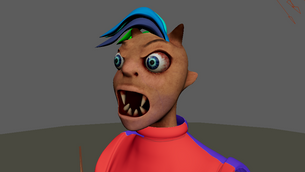Maya and Arnold Shaders
- ShrutiRoyBir

- Nov 22, 2021
- 3 min read
Updated: Oct 11, 2023
Useful fact: The Arnold Standard Surface shader replicates the Arnold Standard Surface shader available in Autodesk® 3DsMax and Autodesk® Maya for the High Definition Render Pipeline (HDRP). When Unity imports an FBX that includes a material using Autodesk's Arnold Standard Surface shader, it applies HDRP's Arnold Standard Surface shader to the material. The material properties and texture inputs are identical between the Unity and Autodesk versions of this shader. like to know more? visit below link.


To assign Arnold material we can just right click and select the new material and then under Arnold tab there are many options and you can select ai standard Arnold shaders and assign the material. As you can see in below picture there is visible difference.
Imp tips:
· It’s always a good idea to change the render device CPU to GPU while practicing render options, it may affect the render quality but help stopping crashing Maya and making PC slow,
· Using Denoiser, improves the render quality.
· If you don’t need sky Dom image to be visible you can just go to sky Dom shape node and turn down the visibility.
It’s really exciting to see the changes in Arnold view how the different options or layers affect the model texture and appearance.
Ai standard surface base layer
Ai standard surface base layer meatless

AiStandardSurface Metalness
I started to play around a bit to understand what works with what.

We didn't have to do much in this. Our main goal was to understand how everything worked. Putting the metalness value at 1, and bringing the roughness value down to 0, gives us this reflective look. It could be used for certain things such as a mirror.
Bringing the roughness value up, gives it a brushed metal look.

Similarly, we can create a gold effect by searching up a gold color on the internet and using it as shown:

I add anisotropy to it and it gives a ring light reflection effect on the surface.

AiStandardSurface specular layer
With the help of the specular attribute we can change the light reflection of a model according to it's surface. Not all materials have the same amount of light reflection and this helps us change the reflection easier.

AiStandardSurface transmission layer
I really liked the effect. It was interesting and cool to do. I used the transmission effect to make it transparent, by changing the depth values I was able to change the color depth giving it more of an illusion effect.

AiStandardSurface Subsurface layer
I played with the values of color and radius color under the subsurface attribute and got the effect that I really liked which resembles the effect we get when we flash the light on our hands and our blood cells appear red.

AiStandardSurface Coat layer
Another dynamic effect that's really useful to create beautiful scenes. There is another attribute called 'coat', where we can manipulate values of roughness and IOR to achieve this reflective surface.

AiStandardSurface Sheen layer
For this workshop I will be using another model to display the silk effect on clothes. While working on this model I realized that the model was by out of triangles anyways, with the sheen attribute we can create such silky effect on clothes by just changing the color of 2 attribute values. We give the base color a dark color and a lighter shade in sheen attribute.

AiStandardSurface Thin Film layer
By far one of my favorites. I used the thin film attribute to give the rainbow shade. Using emission I make the model transparent and to make the model look like its thin (a bubble effect), I click the check box next to 'thin walled' that's found under the geometry attribute. We can also use the metalness attribute to make a metal with a hint of rainbow shade.

AiStandardSurface Emission layer
This effect is similar to the mesh light effect but the model is not really a light. It gives a similar effect to a light by reflecting a bit of light. If we change the values and color in the emission attribute the model starts to glow a bit.

If your model has details, by lowering the weight of the effect you can see the details better.
We can also add an imager to make the model give more of a glowing effect.














Nice little entry, it'll be good to follow up with something that digs deeper into Arnold shaders when you get the chance. Simple but appealing robot for your tests, did you make it? A good bit of info to include :) Wish the screen capture quality was better in order to see it more clearly.